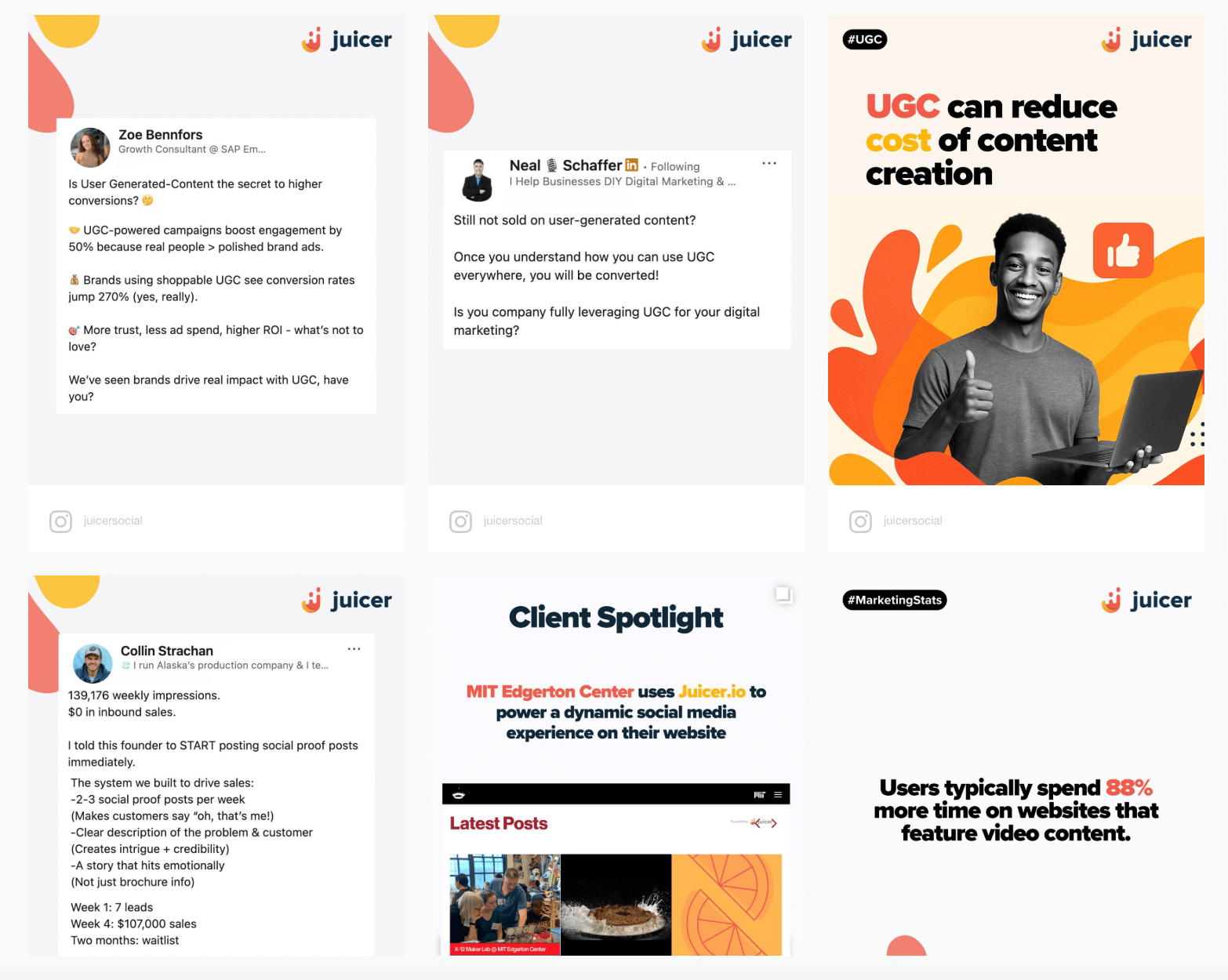Developers love control. But when it comes to social media API integration, control often means complexity: inconsistent data, rate limits, and authentication errors that multiply as you add more platforms.
If you’ve ever tried to directly integrate five or more social media networks into one feed, you probably know what we mean.
Frankly, you can absolutely build an aggregation system yourself. Many organizations do. But maintaining that setup over time becomes the real challenge, if you’re not realistic about what it actually involves. This guide breaks down what can go wrong, how to design a more reliable architecture, and when it makes more sense to use an aggregation platform like Juicer instead of reinventing the wheel.
What API integration actually involves
At its simplest, API integration refers to connecting two or more software components so they can exchange data automatically. In social media, that means pulling social media posts from platforms like Facebook, Instagram, YouTube, X (formerly Twitter), or TikTok through their REST APIs and feeding them into your own system, dashboard, or website.
Sounds easy. It’s not.
Each API has its own data types, endpoints, authentication (usually OAuth), and usage policies. Even the api documentation differs in clarity and depth. And those docs change often — sometimes without notice.
That’s why API integration is a continuous relationship between your software applications and someone else’s evolving ecosystem. Every API update, deprecation, or permission change can break your connection, leading to downtime or missing posts.
The key challenges of integrating multiple social media APIs
Rate limits and quotas
Every social network controls how often your app can call its API.
You might get 200 requests per hour from one platform, 60 from another, and nearly unlimited access from a third. When you’re aggregating content across multiple feeds, those differences create sync delays and missing data unless you build smart caching and queuing systems.
Authentication headaches
OAuth is the industry standard, but it’s far from simple. Tokens expire, permissions get revoked, and some APIs differentiate between personal and business accounts. One expired token can silently break your integration — and your clients’ social media posts stop appearing until you notice.
Inconsistent data structures
Facebook calls it a “message.” Twitter calls it “text.” YouTube calls it “description.”
These aren’t just labels — they’re different data types that require normalization before you can store or display them. Without consistent formatting, your integration process becomes a full-time cleanup job.
Frequent API changes
Social media APIs evolve constantly. New features are added, old ones removed, and api endpoints can shift without backward compatibility. Developers spend hours revising code just to maintain basic functionality. That’s the hidden maintenance overhead of any custom integration project.
Compliance and moderation
Even if your tech works flawlessly, you still need to filter and moderate.
Platforms’ terms of service, privacy policies, and local laws (especially in higher education or social services) require clear controls over what you display publicly. You can’t just stream raw feeds without reviewing for inappropriate content or handling user data responsibly.
Designing a reliable aggregation architecture
If you decide to build your own aggregation system, plan for reliability first. That means designing for failure — because with multiple APIs, something will always fail.
Caching and queuing
Use caching layers to minimize API calls and stay within rate limits. Store recent data sets locally and refresh only when necessary. Implement a queuing system so new posts are fetched asynchronously instead of blocking the entire process.
Error handling and retries
Every API responds differently to errors. Some return HTTP 429 for rate limits; others just time out. Build standardized responses and retry logic to handle these gracefully.
Normalization and mapping
Create an internal schema that converts each platform’s fields into your own structure — for example, always mapping “username” to “author” and “text” to “content.” This ensures consistent data integration across platforms and future-proofs your system.
Scalability
Plan for growth. If your app starts pulling 100 posts a day and scales to 10,000, your integration patterns and database indexing must handle that load. Use lightweight services or containers so you can spin up more instances as needed.
Security and privacy
Social media APIs often involve access tokens tied to users or clients. Store them securely, encrypt at rest, and rotate keys regularly. This is especially critical for sectors like education or social affairs, where compliance failures carry legal risk.
Ensuring compliance and moderation across feeds
As soon as you aggregate public content, you’re responsible for what appears on your website or display. That includes copyright issues, personal data, and inappropriate imagery.
Ignoring this step can turn a simple social integration into a PR issue overnight.
Terms of Service and privacy rules
Every platform has specific rules about how its content can be used. For example, you can’t store certain data from the Facebook API indefinitely, and you can’t alter Instagram posts beyond display formatting. Violating these terms risks losing access entirely.
Moderation layers
Before displaying aggregated posts, add at least one moderation step:
- Manual moderation: A human approves each post. Safe but slow.
- Automatic filtering: Use keyword or hashtag filters to block unwanted content.
- Hybrid models: Flag content for review when it matches sensitive terms (e.g., in political or cultural contexts).
Juicer’s own system includes both manual and auto-moderation — helping organizations from universities to small businesses stay compliant without constant oversight.
Accessibility and diversity considerations
Aggregated social content should reflect the diversity of your users and communities. Avoid bias by rotating sources, mixing data from multiple networks, and ensuring visual accessibility for all audiences. This also aligns with the broader economic and social affairs principles of inclusivity and digital accessibility.
When it makes sense to use an aggregation platform instead
At some point, the cost of maintaining custom integrations outweighs the benefits of control. That’s when tools like Juicer make sense.
The trade-off
Custom builds give you total control but require continuous maintenance: API changes, auth issues, moderation tools, and data normalization never stop.
An aggregation platform like Juicer handles the plumbing for you — with built-in software components, API synchronization, moderation, and real-time updates.
What Juicer’s API adds
Juicer’s social media API gives developers full feed control without the overhead of managing every endpoint themselves. You can:
- Pull social media posts from 15+ platforms
- Apply keyword or hashtag filters
- Moderate manually or automatically
- Style feeds with CSS or choose pre-built themes
- Embed directly on your websites, landing pages, or event displays
- Access analytics for engagement and performance
Essentially, you get the benefits of robust API integration without the constant firefighting. That means your developers can focus on creating new features, improving UX, or scaling other portions of your product — instead of chasing rate-limit errors.

Deciding what integration approach works for your organization
If you’re a developer working inside a larger company or higher education institution, ask these questions before deciding:
- How many platforms do we really need to aggregate?
- Do we have the resources to handle long-term maintenance?
- Are there compliance or moderation requirements we can’t automate?
- Is the content central to our business — or just part of our marketing and communication strategy?
For most organizations, especially small businesses, using a managed aggregation platform is simply more efficient. It gives them the benefits of integration, data access, and cross-platform communication without requiring a dedicated API engineer.
If you’re an agency or SaaS company, the argument is even stronger. Juicer integrates with all major social networks, can be branded or white-labeled, and includes an API for advanced customization — so you can still build unique experiences on top of it. For more details, see this comparison of Juicer vs. EmbedSocial.
Example architecture: hybrid approach
For teams that still want flexibility, consider a hybrid model:
- Use Juicer’s social media API for aggregation and moderation.
- Store approved content in your own database for analytics or personalization.
- Use your app’s automation layer to display or trigger events (e.g., highlight new mentions, sync with marketing campaigns, or post updates to internal apps).
This model keeps your front-end experience custom while offloading maintenance, compliance, and API versioning to a stable provider. It’s also easier to justify to non-technical stakeholders: faster setup, fewer surprises, and predictable costs.
There’s a human need for proper integration
Building great integrations isn’t just about connecting systems — it’s about supporting the people who use them.
It’s not just a ‘nice to have’. When your feed breaks or your data stops updating, it affects the users, teams, and social communities relying on that visibility.
For universities, it means losing real-time student content during orientation.
For agencies, it can mean missing a campaign deadline.
For brands, it means losing social proof on high-traffic pages.
A platform like Juicer reduces that risk. No, it’s doesn’t replace your human, technical talent; what it does is frees their brains and calendars to focus on what moves your business forward — creative campaigns, research, UX, and growth.
Compliance, moderation, and the future of aggregation
The future of social integration will be more about trust than technology. Governments and social affairs organizations are tightening privacy regulations. Platforms are limiting third-party access. And companies are expected to demonstrate accountability for how they use social data.
Reliable integration patterns will therefore need:
- Transparent data handling – clear about what’s stored and for how long.
- Ethical moderation – removing harmful or biased content before it reaches the public eye.
- Interoperability – ability to connect safely with new APIs or apps as they emerge.
Juicer is built around those ideas. It connects safely, filters responsibly, and gives developers API access without compromising compliance.
Next steps for developers
If you’re evaluating your integration options, here’s how to move forward:
- Audit your current setup – Map out every API, data flow, and manual process. Identify where failures or bottlenecks occur.
- Calculate maintenance cost – Track how many hours per month are spent fixing or updating integrations.
- Test an aggregation API – Use Juicer’s free tier to experiment with feed integration and moderation settings.
- Plan your moderation workflow – Define who reviews content, what’s filtered automatically, and how you’ll handle flagged posts.
- Scale smart – Add more social media networks only once you can handle the current load reliably.
The goal is to enable your engineering to spend their precious time where it delivers value, not keep them busy with upkeep.

API integration made easy
Juicer gives you the reliable aggregation layer you need to keep your feeds alive, compliant, and visually on-brand — without endless maintenance. We’re here to answer all your questions, or you can explore the topic further.
👉 Explore the Juicer API
👉 Read our API documentation
👉 Juicer.io Support Center




